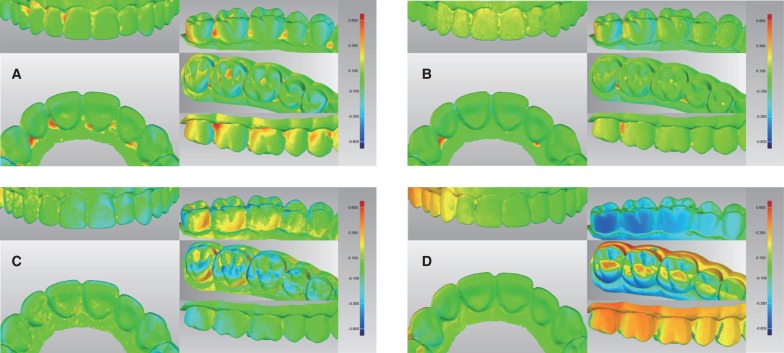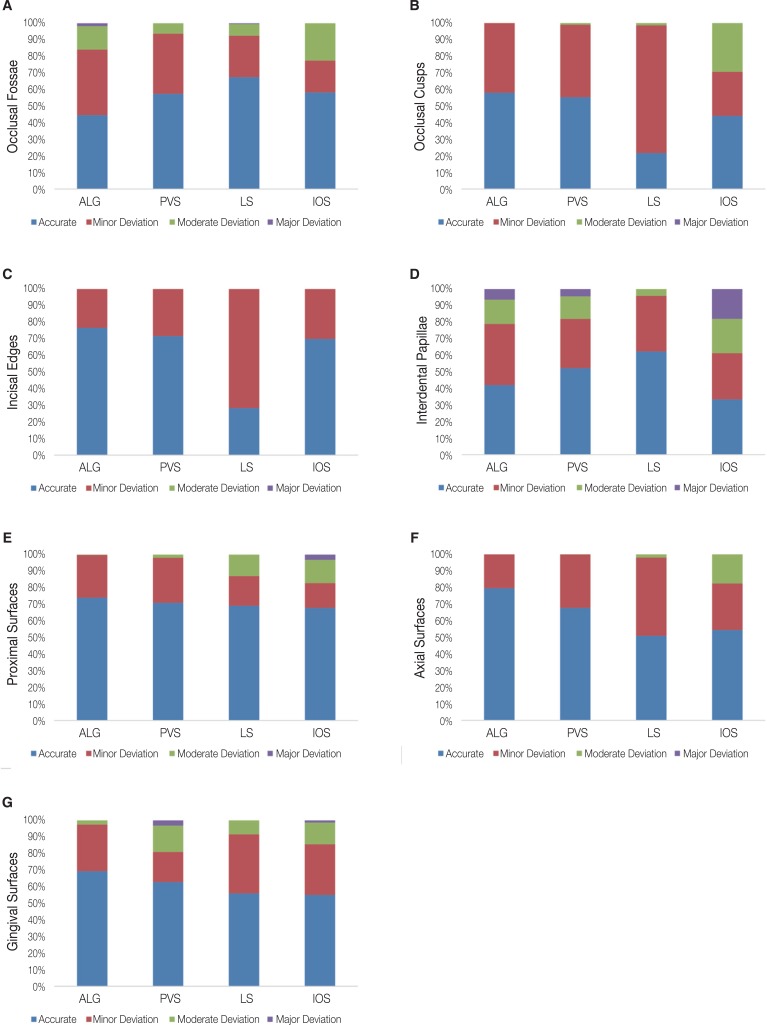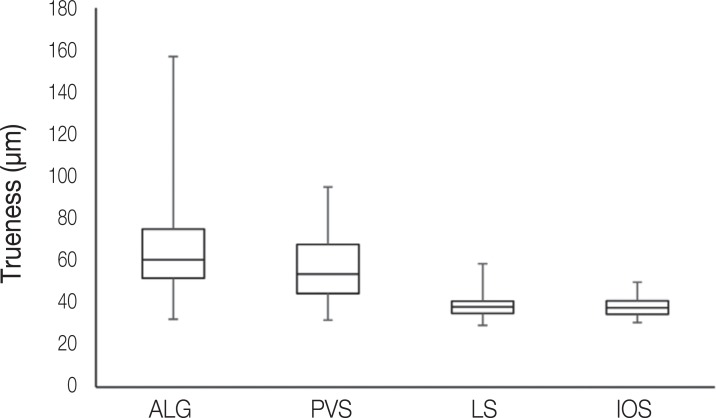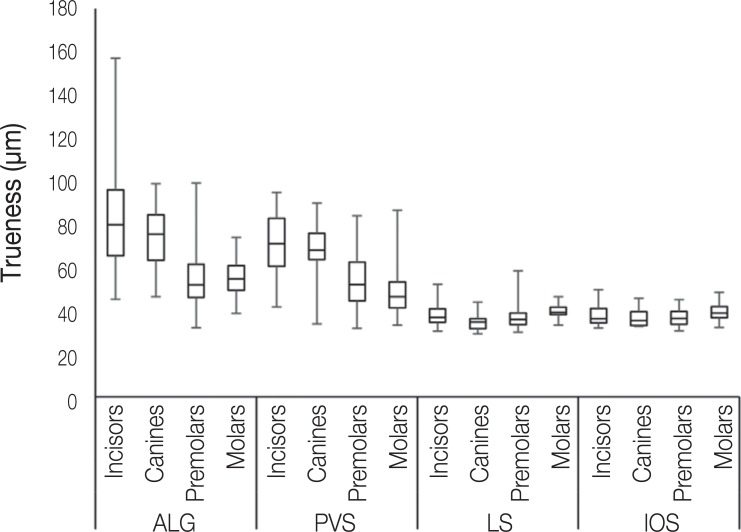J Adv Prosthodont.
2019 Apr;11(2):138-146. 10.4047/jap.2019.11.2.138.
Accuracy of casts produced from conventional and digital workflows: A qualitative and quantitative analyses
- Affiliations
-
- 1Restorative Section, Melbourne Dental School, Melbourne University, Victoria, Australia. jaafar.abduo@unimelb.edu.au
- KMID: 2444148
- DOI: http://doi.org/10.4047/jap.2019.11.2.138
Abstract
- PURPOSE
Comparing the accuracy of casts produced from digital workflow to that of casts produced from conventional techniques.
MATERIALS AND METHODS
Whole arch alginate (ALG) and polyvinyl siloxane (PVS) impressions were taken with stock trays and custom trays, respectively. The ALG impressions were poured with type III dental stone, while the PVS impressions were poured with type IV dental stone. For the digital workflow, IOS impressions were taken and physical casts were produced by 3D printing. In addition, 3D printed casts were produced from images obtained from a laboratory scanner (LS). For each technique, a total of 10 casts were produced. The accuracies of the whole arch and separated teeth were virtually quantified.
RESULTS
Whole arch cast accuracy was more superior for PVS followed by LS, ALG, and IOS. The PVS and ALG groups were inferior in the areas more susceptible to impression material distortion, such as fossae and undercut regions. The LS casts appeared to have generalized errors of minor magnitude influencing primarily the posterior teeth. The IOS casts were considerably more affected at the posterior region. On the contrary, the IOS and LS casts were more superior for single tooth accuracy followed by PVS and ALG.
CONCLUSION
For whole arch accuracy, casts produced from IOS were inferior to those produced from PVS and ALG. The inferior outcome of IOS appears to be related to the span of scanning. For single tooth accuracy, IOS showed superior accuracy compared to conventional impressions.
Keyword
Figure
Reference
-
1. Fokkinga WA, Witter DJ, Bronkhorst EM, Creugers NH. Clinical fit of partial removable dental prostheses based on alginate or polyvinyl siloxane impressions. Int J Prosthodont. 2017; 30:33–37. PMID: 28085976.
Article2. Gordon GE, Johnson GH, Drennon DG. The effect of tray selection on the accuracy of elastomeric impression materials. J Prosthet Dent. 1990; 63:12–15. PMID: 2404101.
Article3. Rueda LJ, Sy-Muñoz JT, Naylor WP, Goodacre CJ, Swartz ML. The effect of using custom or stock trays on the accuracy of gypsum casts. Int J Prosthodont. 1996; 9:367–373. PMID: 8957875.4. Ceyhan JA, Johnson GH, Lepe X. The effect of tray selection, viscosity of impression material, and sequence of pour on the accuracy of dies made from dual-arch impressions. J Prosthet Dent. 2003; 90:143–149. PMID: 12886207.
Article5. de Araujo PA, Jorgensen KD. Effect of material bulk and undercuts on the accuracy of impression materials. J Prosthet Dent. 1985; 54:791–794. PMID: 3908659.
Article6. Kuhr F, Schmidt A, Rehmann P, Wöstmann B. A new method for assessing the accuracy of full arch impressions in patients. J Dent. 2016; 55:68–74. PMID: 27717754.
Article7. Atieh MA, Ritter AV, Ko CC, Duqum I. Accuracy evaluation of intraoral optical impressions: A clinical study using a reference appliance. J Prosthet Dent. 2017; 118:400–405. PMID: 28222869.
Article8. Ender A, Attin T, Mehl A. In vivo precision of conventional and digital methods of obtaining complete-arch dental impressions. J Prosthet Dent. 2016; 115:313–320. PMID: 26548890.9. Flügge TV, Schlager S, Nelson K, Nahles S, Metzger MC. Precision of intraoral digital dental impressions with i'Tero and extraoral digitization with the iTero and a model scanner. Am J Orthod Dentofacial Orthop. 2013; 144:471–478. PMID: 23992820.
Article10. Ender A, Mehl A. In-vitro evaluation of the accuracy of conventional and digital methods of obtaining full-arch dental impressions. Quintessence Int. 2015; 46:9–17. PMID: 25019118.11. Abduo J, Lyons K, Bennamoun M. Trends in computer-aided manufacturing in prosthodontics: a review of the available streams. Int J Dent. 2014; 2014:783948. PMID: 24817888.
Article12. Al-Imam H, Gram M, Benetti AR, Gotfredsen K. Accuracy of stereolithography additive casts used in a digital workflow. J Prosthet Dent. 2018; 119:580–585. PMID: 28781073.
Article13. Sim JY, Jang Y, Kim WC, Kim HY, Lee DH, Kim JH. Comparing the accuracy (trueness and precision) of models of fixed dental prostheses fabricated by digital and conventional workflows. J Prosthodont Res. 2019; 63:25–30. PMID: 29615324.
Article14. Jin SJ, Kim DY, Kim JH, Kim WC. Accuracy of dental replica models using photopolymer materials in additive manufacturing: In vitro three-dimensional evaluation. J Prosthodont. 2019; 28:e557–e562. PMID: 29968424.
Article15. Wesemann C, Muallah J, Mah J, Bumann A. Accuracy and efficiency of full-arch digitalization and 3D printing: A comparison between desktop model scanners, an intraoral scanner, a CBCT model scan, and stereolithographic 3D printing. Quintessence Int. 2017; 48:41–50. PMID: 27834416.16. Ishida Y, Miyasaka T. Dimensional accuracy of dental casting patterns created by 3D printers. Dent Mater J. 2016; 35:250–256. PMID: 27041015.
Article17. Abduo J, Elseyoufi M. Accuracy of intraoral scanners: A systematic review of influencing factors. Eur J Prosthodont Restor Dent. 2018; 26:101–121. PMID: 29989757.18. Eftekhar Ashtiani R, Nasiri Khanlar L, Mahshid M, Moshaverinia A. Comparison of dimensional accuracy of conventionally and digitally manufactured intracoronal restorations. J Prosthet Dent. 2018; 119:233–238. PMID: 28578984.
Article19. Anadioti E, Aquilino SA, Gratton DG, Holloway JA, Denry I, Thomas GW, Qian F. 3D and 2D marginal fit of pressed and CAD/CAM lithium disilicate crowns made from digital and conventional impressions. J Prosthodont. 2014; 23:610–617. PMID: 24995593.
Article20. ISO 5725-1. Accuracy (trueness and precision) of measurement methods and results - Part 1: General principles and definitions. Geneva; Switzerland: International Standards Organization (ISO);1994. Accessed August, 2018. Available at:https://www.iso.org/standard/11833.html.21. Ender A, Mehl A. Accuracy of complete-arch dental impressions: a new method of measuring trueness and precision. J Prosthet Dent. 2013; 109:121–128. PMID: 23395338.
Article22. Jeong ID, Lee JJ, Jeon JH, Kim JH, Kim HY, Kim WC. Accuracy of complete-arch model using an intraoral video scanner: An in vitro study. J Prosthet Dent. 2016; 115:755–759. PMID: 26794703.23. Atieh MA, Ritter AV, Ko CC, Duqum I. Accuracy evaluation of intraoral optical impressions: A clinical study using a reference appliance. J Prosthet Dent. 2017; 118:400–405. PMID: 28222869.
Article24. Su TS, Sun J. Comparison of repeatability between intraoral digital scanner and extraoral digital scanner: An in-vitro study. J Prosthodont Res. 2015; 59:236–242. PMID: 26211702.
Article25. Lee JJ, Jeong ID, Park JY, Jeon JH, Kim JH, Kim WC. Accuracy of single-abutment digital cast obtained using intraoral and cast scanners. J Prosthet Dent. 2017; 117:253–259. PMID: 27666500.
Article26. Cho SH, Schaefer O, Thompson GA, Guentsch A. Comparison of accuracy and reproducibility of casts made by digital and conventional methods. J Prosthet Dent. 2015; 113:310–315. PMID: 25682531.
Article27. Ng J, Ruse D, Wyatt C. A comparison of the marginal fit of crowns fabricated with digital and conventional methods. J Prosthet Dent. 2014; 112:555–560. PMID: 24630399.
Article28. Rossini G, Parrini S, Castroflorio T, Deregibus A, Debernardi CL. Diagnostic accuracy and measurement sensitivity of digital models for orthodontic purposes: A systematic review. Am J Orthod Dentofacial Orthop. 2016; 149:161–170. PMID: 26827972.
- Full Text Links
- Actions
-
Cited
- CITED
-
- Close
- Share
- Similar articles
-
- Comparison of accuracy between digital and conventional implant impressions: two and three dimensional evaluations
- Accuracy and time efficiency of conventional and digital outlining of extensions of denture foundation on preliminary casts
- Evaluation of the accuracy of dental casts manufactured with 3D printing technique in the All-on-4 treatment concept
- The accuracy of a 3D printing surgical guide determined by CBCT and model analysis
- COMPARISON OF THE ACCURACY OF STONE CASTS MADE FROM ALGINATE IMPRESSION MATERIAL BY MIXING METHODS AND APPLICATION OF TRAY ADHESIVE







